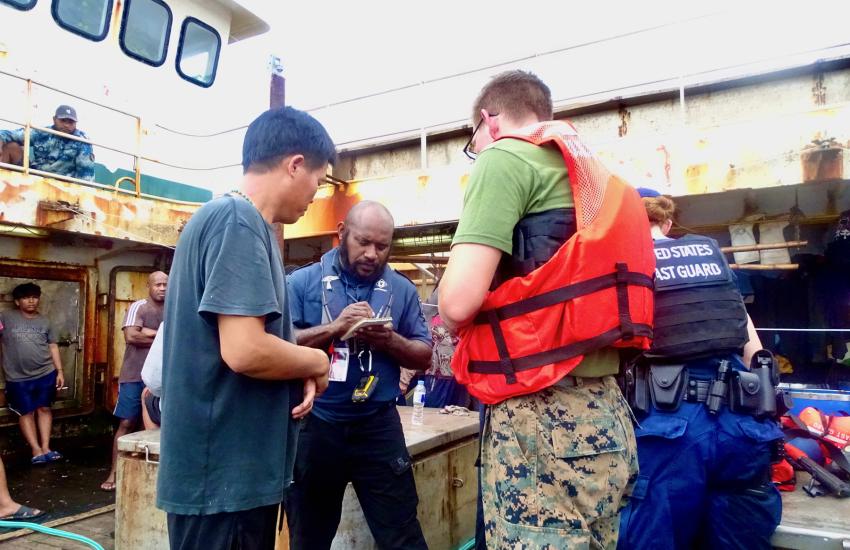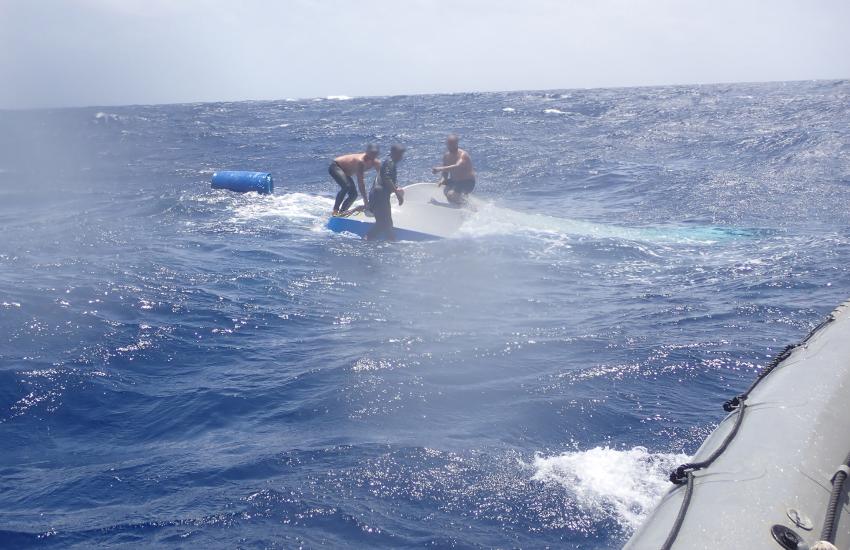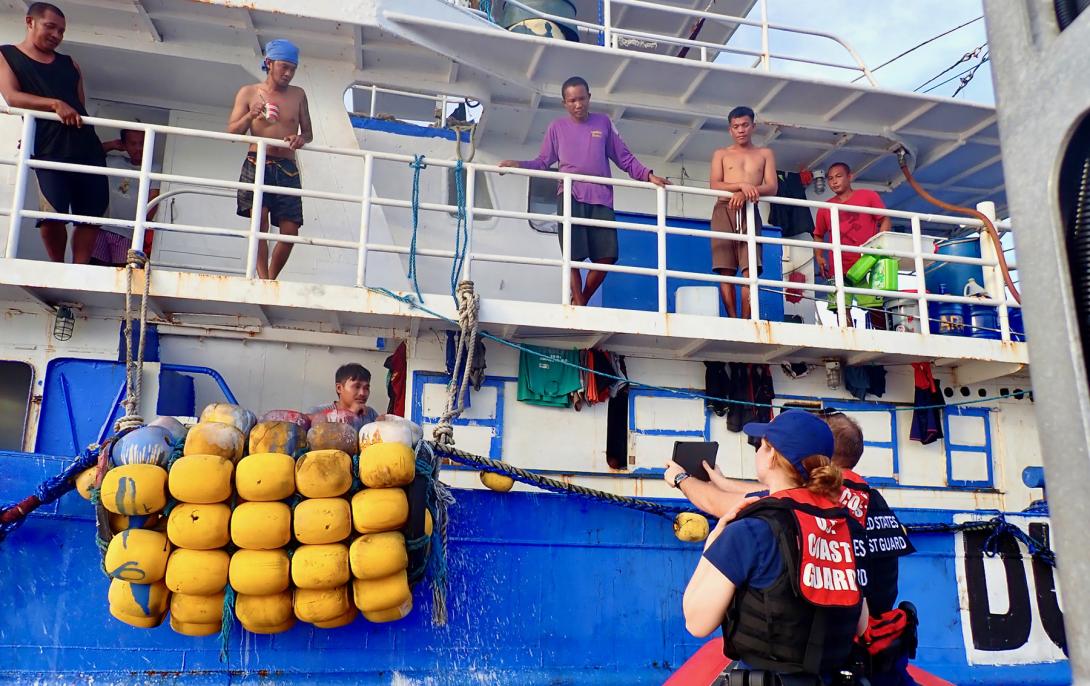Coast Guard Integrates AI at the Sea’s Edge
Exchanging a few words in another language has been simplified since the advent of large language models. With high-bandwidth connections and generous wireless data, anyone can have a friendly exchange with a native of distant lands.
But when these natives are not on land, the situation may change. And the U.S. Coast Guard (USCG) must operate in an environment hostile to people and machines as unregistered boats carrying suspected illegal migrants sail toward the country’s coasts.
“Our crews are tasked with interdicting these vessels, sometimes in international waters and embarking all the migrants on board and processing them,” said Lt. Cmdr. Nicholas Phillips, Coast Guard Headquarters Office of Maritime Law Enforcement Policy.
The Coast Guard operates in an environment that is generally uncontested but presents most of the technical challenges of edge computing, including low bandwidth and the need to keep devices portable and dry.
These conditions inspired innovation.
The USCG launched project Minerva, a comprehensive initiative to connect assets in real time, leveraging artificial intelligence (AI). This will bring data to decision-makers in real time to command and control activities.
In turn, this sparked a series of technology adoptions and adaptations.
One is connectivity.
Sometimes, commercial cellular data links are available, and cutters also have satellite communications, but a leap of this nature demands better latency when not within 5G coverage.
“We’ve been using older satellite communications technology, but we’ve recently been deploying low-Earth orbit, proliferated low-Earth-orbit satellites,” said Michael Greene, Intelligence and Information Sharing C5I program manager, USCG.
Operating at the edge is critical, given the type of processes the USCG performs.
“It’s been very challenging to manage the migrants we have in our care,” explained Cmdr. Phillips. Identifying each individual used to be a manual operation until a browser-based application was released.
Service members employ this app to gather personal details that allow individualizing people who could potentially break migration laws when the USCG interdicts a vessel at sea. Presumed migrants are given a number, and that information is relayed to the cutter when and if there is a data connection, Cmdr. Phillips told SIGNAL Media in an interview.
“The interdicting unit there at sea will be able to enter a lot of this information in this browser-based application and then it will replicate in near real time,” Cmdr. Phillips said.
But basic communication is often impossible when trying to speak with people from diverse origins, including Asia, Africa and the Americas.
The USCG boarded 12,000 vessels in 2022 for drug interdictions, distress calls, saving migrants and inspections. It was impossible to communicate with many of these crews as human translators are not always available, according to the Coast Guard.
To tackle this, the service has developed a device that identifies and translates 16 languages back and forth. It leverages AI to detect and refine the exchange. While this device was developed jointly by the Coast Guard and the Department of Homeland Security (DHS) Science and Technology Directorate, this agency declined to comment and deferred to the USCG.
Achieving this performance at the edge in a portable device is no easy feat.
“Typically, when we start talking about AI-enabled processing, where now you’re disconnected from any cloud-based architecture, you have to be extremely aware of the environment that you’re in,” said Roopa Vasan, chief AI architect at Leidos, a defense technology company.
Vasan explained that there are three challenges for these devices:
1. Placing sensors
2. Communications or
network restrictions
3. Coordination
On this last point, Vasan, an edge processing specialist, added, “What you want to do is be able to orchestrate or get information from those distributed assets in a way that increases the ability to understand what’s happening in an area of interest, wherever that may be.”
And the data should also be accessible along the chain of command.
“The constant information flow, as these decisions are getting adjudicated based on the facts at the headquarters level and across the Beltway and the interagency, and then communicating that down through the operational commander and then to our unit that’s on scene,” Cmdr. Phillips said.
Still, achieving this kind of performance with handheld devices in a hostile environment implies designing around difficult-to-balance tradeoffs.
“Size, weight and power are typically the three underlying components—what we call ‘SWaP,’” Vasan told SIGNAL Media in an interview.
In the case of the translation device for the USCG, making it a reality is a long process.
“When you start thinking about edge AI, this is not about some developer working in a lab; you actually have to work collaboratively with the engineers, with the system owner, to not just do the design ahead of time, looking at the power the SWaP budgets, but also how you test and evaluate that on the edge,” Vasan said.
And the best way to map problems is by employing these devices in situations that best resemble the real world.
“You want to test it in that environment, where it’s going to be used in, to assess the suitability of it for meeting needs,” said Greene.

Where the system is expected to operate creates two sets of challenges, one of which concerns the physical environment itself.
“We’re looking to give our frontline operators, as our maritime environment is a harsh environment obviously, salt water is very harsh, with rusting and corroding,” Cmdr. Phillips said.
The second set involves parsing the right data.
“If it’s something like waves, and there’s a regular kind of noise, that can be filtered out; if they have a known spectral profile, maybe you can filter those out,” said Sowmya Ramachandran, senior research scientist at Stottler Henke, an intelligent software developer. “But if there are a lot of conversations, overlapping conversations for instance, if there’s noise of that form, that’s maybe not very regular, then detecting the signal from the noise becomes a problem,” Ramachandran added.
Once operators can communicate data and enter biographical and biometrical information during an interdiction, what used to be slow administrative work becomes a streamlined system.
Cmdr. Phillips explained the role of these enrollments, which allow the Coast Guard to cross-check individuals against various government databases, identifying previous encounters or legal statuses in real or near-real time.
Once an individual is known to the DHS and Coast Guardsmen encounter them during an interdiction, there is an added security layer.
“You know specifically if they have any kind of medical concerns, or things of that nature, that we need to be attuned to,” Cmdr. Phillips explained.
The other extreme is when front-line personnel are made aware that someone has a known criminal past if two-way links are up.
Still, even U.S. citizens have been known to sail aboard vessels interdicted. Therefore, the highest standards apply to how all data is protected.
Greene stressed the importance of security for Coast Guard devices, particularly the use of mobile device management to protect sensitive data.
“We only put the information on government-owned devices because we know we have full control of those devices, and we have the ability to—and we have confidence that—we are protecting the information properly,” Greene said.
He also explained that fully adopting capabilities like real-time translation and records leveraging AI was still a work in progress.






Comments